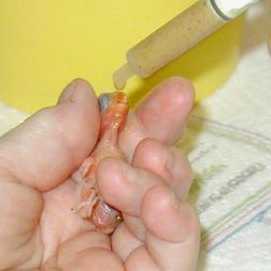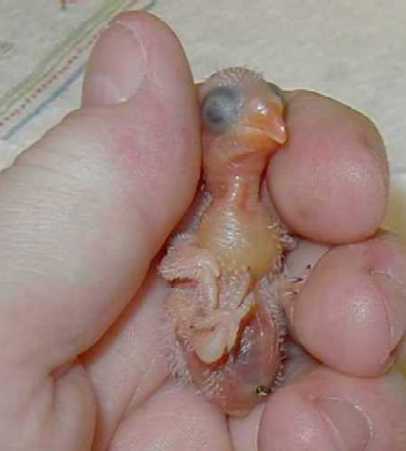Hand Feeding Baby Lovebirds From Day 1

Hand feeding any baby Lovebird is a commitment, but hand-feeding a baby Lovebird from day 1 is a commitment, plus labor of love! Hatchling babies are very tiny, in addition to being very uncooperative.
The most important thing to consider when feeding a baby this young is timing. Parent Love birds feed their young around the clock for the first 7-10 days, and the hand feeder must also do this. Hatchlings are fed every 2 hours round the clock for the first 5 days. The schedule changes after day 5 and I will discuss this later.
The items needed for a hatchling are the same as for an older baby but there are a few other that are necessary with a day 1.
- Hand feeding formula (22/9 - 22% protein, 9% fat)
- Lactobacillus (for digestive bacteria)
- Papaya (for digestive enzymes)
- Enfalyte or Pedialyte (suggested for the first 5 days)
- Small "O" ring syringe (I prefer 3 cc) or a small tapered tip eyedropper
- Small container to mix formula
- Thermometer (to check temperature of the formula)
- Disinfectant to clean syringes and utensils when finished (10% bleach solution or Oxyfresh)
Proper feeding temperature is still 106F-108F. Mom feeds at the same temperature, regardless of age. With hatchlings, feeding amount is measured in drops rather than by cc. If the very first feeding is 6-8 drops, that is a lot! This picture shows how full the crop should be for a day 1 lovebird baby. Note that the crop is full and the formula stops at the base of the throat.

How Much to Feed a Hatchling Baby Lovebird
Deciding when to feed a day 1 chick for the first time can be tricky. If I do an assisted hatch and choose to feed the baby myself, I wait about 6 hours before I feed. Feeding too soon can kill the chick. If the baby has been with mom and I discover she isn't feeding, enough time has usually passed were it's safe to feed immediately.
For the first couple of feedings, I use just Enfalyte or Pedialyte. This is to make sure that the digestive system is functioning before I feed anything that is harder to digest. As soon as I see that the baby has eliminated 3 separate times, I know I can begin feeding formula. As each formula is different, you will need to follow the mixing instructions on the individual packaging.
There are several things to remember when feeding a day 1 baby.
- Hatchlings are very small and tend to be uncooperative. Very young baby lovebirds are fed on their backs at this age because they have very heavy bodies and their legs won't support their weight. Until the baby gets used to the feeding routine, it will tend to squirm and wiggle.
- Hatchlings need to learn how to eat from a syringe. This is not normal for them and it can take up to a half dozen feedings before the baby gets the idea. Since I'm right-handed, I feed from the side closest to me, the baby's right side. Left-handed would be the just the opposite. I do this so that I can see what is going on. The tip of the syringe will not actually go into the baby's mouth, so very small drops will find their way to the back of the baby's throat. Even though I'm using a very small syringe, many times more will be on the baby than in the baby! I watch the baby's crop to determine when I've fed enough. Only drops that go into the mouth count! The picture directly below shows positioning when feeding a day 1 baby.
- Formula will cool quicker when you use a small syringe. I always have a container of hot water (110F-115F) that I can dip my syringe in so that I can keep the formula warm. Between drops, I put at least the tip of the syringe in the container of hot water. Formula will also cool in the very short time that it takes to go from the tip of the syringe to the baby's mouth.
- When hand feeding a baby this young, always watch the baby's mouth as you feed/as it eats. If the drops of formula are a bit too big, it's very easy for the baby to aspirate (inhale liquid into the lungs) and die.
 |
| Feeding Schedule |
Another Schedule to Food Servings For Baby Lovebirds :
Most important supplies: scale made for birds, O-ring syringes, Oxyfresh Cleaning Gel, bottle warmer made for human babies, a brooder that stays between 73-83 F, and Roudybush Handfeeding Formula (consistency of split pea soup to a heavy gravy served between 103-109 F with no dry, solid spots. Nothing should ever be added to the formula, and the formula should have the same thickness consistency from two weeks until weaned.)
2 weeks old:
5 feedings every 4 hours (8:00am, 12:00pm, 4:00pm, 8:00pm, 12:00am.) Many other breeders only feed 4 times every 4 hours the first week, but we do not want the babies crying for food in the middle of the night. Just like human babies, there are small babies (Pixy!) and there are large babies (her brother Jelly Bean!), so the amount of food is going to vary around 3.5-4.5 cc’s. Tamara and I do not say, “Ok baby, you have had 4 ccs, your full!” No, we fill up the babies until their crops resemble a full balloon or when they simply do not want anymore. Feed the babies all at once; competition is your greatest ally. Well-socialization goal: babies should recognize you, have a wonderful feeding response, and have names.
3 weeks old:
4 feedings every 4 hours (8:00am, 12:00pm, 4:00pm, 8:00pm.) Just fill those crops until they look and feel like a full balloon. At 3.5 weeks old, the babies will start to chew on their bedding. This is the time to introduce “big bird” food. Fresh, chewy Avicakes are the perfect introduction to solid food. Avicakes are highly nutritious unlike seed or millet. After babies are fed baby food, place a very small crumb into their mouths. This works great as a birdie pacifier also. We never feed them mashed-up or soft foods for weaning. Starting them on what they will eat as adults is best. After they are eating “big bird” food, we introduce small foot toys and toys they can shred. Well-socialization goal: babies try “big bird” food, recognize your voice, and step-up on your palm to be fed.
4 weeks old:
3 feedings every 6 hours (8:00am, 2:00pm, 8:00pm.) We never drop their feedings to three until we know they are eating the Avicakes on a regular basis. This is the time when we introduce crushed-up Nutri-Berries and a small pellet like Roudybush Crumble. Depending on the size of the baby, they should be receiving around 6 ccs at this point. Once again, feel the crop and if the babies refuse, do not force them to eat. After we feed them baby food, we place them over the solid food bowl. This is the time we introduce a small dish of water also. Well-socialization goal: babies play with toys, eating adult food on a regular basis, and cry out not only for baby food, but for attention also. Some of the older babies at this point have a natural protective instinct of their siblings and territory, so to dilute this trait we lay down on the floor, cuddle, play with them with their toys, and feed them adult food by hand after each feeding. When they have fallen asleep, we place them back into the brooder.
5 weeks old:
2 feedings every 12 hours (8:00am and 8:00pm or 6:00pm if some of the babies are screaming.) At 5.5 weeks of age the babies will start to fly. There first flight is always to us. This is always a true sign that your babies see you more than just the ones who feed you. It is a sign that they love you. This is one of the most awesome milestones for baby’s socialization. This is also the week we introduce seed, because as the babies wean they need that extra burst of energy that the fat in seed has in storage. The fat also fills them up more and helps them strive between feedings. Concerning feedings, some babies at this age take well over 8 ccs of baby food. When we reach 1 feeding per day, they can receive up to as much as 10 ccs.
6 weeks old:
1 feeding per day at 6:00pm or 8:00pm (babies can feed from 7-10 ccs at this point.) If we have a large clutch, 4 or more babies, the prodigies will normally wean during this week.
7 weeks old:
A baby should wean at anytime now. If they do not cry for their evening feeding, then do not give it to them. At 7 weeks, we introduce cooked foods, fruits, sprouts, and veggies. The babies will see the adults eating the food and will follow their lead.
They should be fully weaned by 8 weeks.
See Lovebird Growth Picture Days 1 to Days 35
:)
Great info!! Where can I get the papaya & good bacteria, & digestive enzymes? Human grade or is there a formulation for birds? Thank you!!
ReplyDelete
ReplyDeleteAwesome post with perfect guidelines in baby feeding guide.keep update your blog.
Thank you very very useful to me for my baby love birds
ReplyDeleteWhy my 20 days old African lovebird not eating hand feeding food since I bought it day before yesterday from pet shop by seperating from his mother?
ReplyDelete